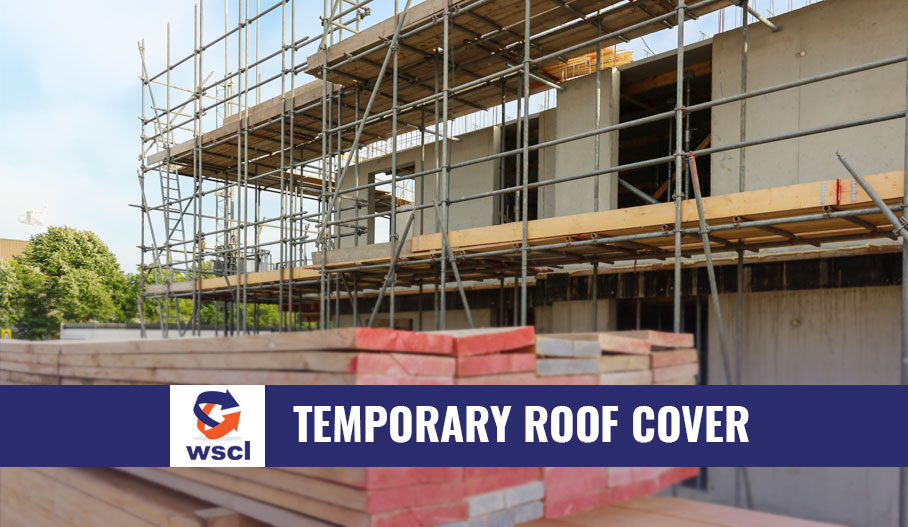There are many different types of temporary roof cover solutions available today, and this can make it difficult when it comes to narrowing down your search. However, there is no need to worry, as we have got you covered. In this blog post, we are going to talk you through the different options that are available and when they are going to be suitable for you. If you have any queries, please do not hesitate to get in touch with us and we would be more than happy to assist you.
What is a temporary roof cover?
A temporary roof is typically used to create a weather-protected covering for a building project. There are a number of different sheeting options for you to choose from when it comes to cladding for a temporary roof. This includes zinc roofing sheets or tin roofing sheets. You also have temporary roofing systems, for example, Ubix and Haki, as well as shrink wrap sheeting. The reason why there are so many options because, there are many different scenarios and environments that call for a temporary roof. With that in mind, below, we are going to take a look at some of the different types of temporary roof covers, revealing their pros and cons, as well as some advice on when it is most suitable to use the roof covering in question.
What is shrink wrap?
Shrink wrap sheeting tends to be used as an alternative to the traditional scaffolding sheeting so that scaffold cladding can be encapsulated for temporary protection from the weather and/or containment of the work that is being carried out. This type of temporary roof cover is not going to be right for every construction project. However, more and more contractors and scaffolders are going down this route because they are looking for scaffolding sheeting that is more robust. You want something that is not going to become saggy or loose over time, and this is what you are going to get with this solution. Not only this but shrink wrapping is also going to offer a fully sealed skin around the work area. It tends to be the best option when working on awkward and smaller temporary roofs.
Corrugated Iron
There is only one place to begin, and this is with corrugated iron, as it is the traditional material that is used to cover temporary roof scaffolding sheets. These sheets can also be referred to as CI sheets or tin sheets. The best way to describe it is simply putting a tin over a construction project. One of the main advantages of going down this route is that the corrugated iron sheets can be used again and again, which means you are going to benefit from great value for money. However, it is worth noting that the cost of fitting can be high because they need to be lifted into position. There are a few other drawbacks that you need to be aware of as well. This includes the fact that this type of temporary roofing option is not going to let light through to the work area underneath, which may be important in a lot of situations.
Keder roofs
A lot of people have made the switch to Keder temporary roof coverings. This is a type of roof sheeting technique that is used by a large number of manufacturers today. With this solution, aluminium beams will be fitted – either 3 m or 1.5 m in length, and they are fitted together. This results in a roof environment that bists excellent durability, with an expected lifespan of 15 years. When the beams have been installed, sheeting is pulled through the tracks in the beams. This sheeting is sealed with beads, i.e. Keder. Not only are these roof coverings reusable but they create a light working environment as well, which is something you are not going to get with corrugated iron sheets. However, this option can be expensive and it is not as versatile as shrink wrap.
Considerations when it comes to temporary roofing projects
There are a number of different considerations that companies are going to have in mind when it comes to temporary roofing projects. Firstly, weather resistance is going to be of huge importance. When compared with a tin sheet roof, shrink wrap sheeting can be better in terms of weather resistance, as there are less joints. Moreover, the joints that are present will be sealed using heat welding. There is going to be much less opportunity for the rain to penetrate if there are fewer gaps.
Aside from this, other factors that need to be considered is when the temporary roof is going to be dismantled and how this is going to be the case. Appearance is a critical consideration, as is budget. Speeding of fitting is one of the most important factors for clients, as there is often not going to be a lot of time to waste when it comes to fitting a temporary roof. You need to choose a company that is going to understand all of your requirements in this regard and do everything in their power to cater to them.
Contact us today for more information
If you would like to find out more about the different scaffolding roof protection options that we have for sale, please do not hesitate to get in touch with us for more information. If you are unsure regarding the right type of temporary roof cover for your needs, there is no need to worry. All you need to do is give us a call and you will speak to one of our friendly and experienced specialists who will be more than happy to help you in any manner they can, including providing you with a free, no-obligation quotation. You can reach us on 02392 983 804 or 07766 456 851. Alternatively, you can send an email to info@wsclltd.co.uk, and we will get back to you as soon as possible.

